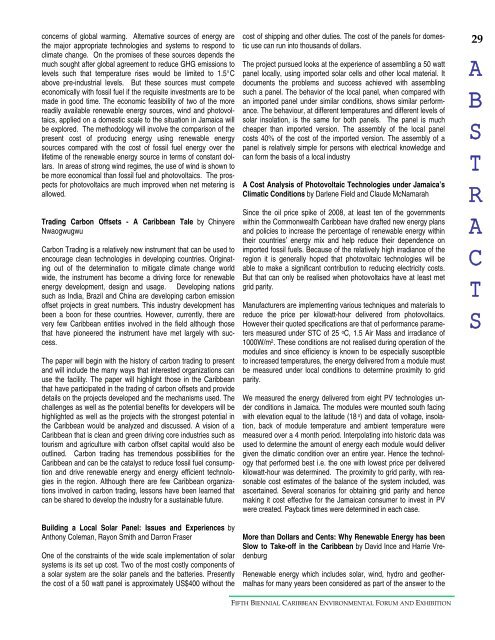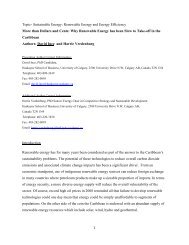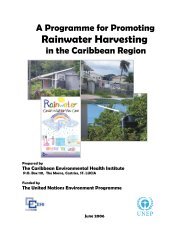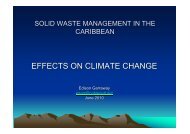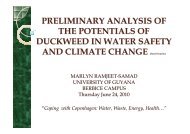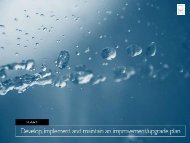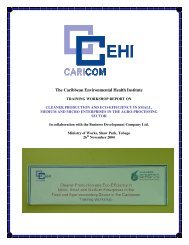conference magazine - Caribbean Environmental Health Institute
conference magazine - Caribbean Environmental Health Institute
conference magazine - Caribbean Environmental Health Institute
Create successful ePaper yourself
Turn your PDF publications into a flip-book with our unique Google optimized e-Paper software.
concerns of global warming. Alternative sources of energy are<br />
the major appropriate technologies and systems to respond to<br />
climate change. On the promises of these sources depends the<br />
much sought after global agreement to reduce GHG emissions to<br />
levels such that temperature rises would be limited to 1.5°C<br />
above pre-industrial levels. But these sources must compete<br />
economically with fossil fuel if the requisite investments are to be<br />
made in good time. The economic feasibility of two of the more<br />
readily available renewable energy sources, wind and photovoltaics,<br />
applied on a domestic scale to the situation in Jamaica will<br />
be explored. The methodology will involve the comparison of the<br />
present cost of producing energy using renewable energy<br />
sources compared with the cost of fossil fuel energy over the<br />
lifetime of the renewable energy source in terms of constant dollars.<br />
In areas of strong wind regimes, the use of wind is shown to<br />
be more economical than fossil fuel and photovoltaics. The prospects<br />
for photovoltaics are much improved when net metering is<br />
allowed.<br />
Trading Carbon Offsets - A <strong>Caribbean</strong> Tale by Chinyere<br />
Nwaogwugwu<br />
Carbon Trading is a relatively new instrument that can be used to<br />
encourage clean technologies in developing countries. Originating<br />
out of the determination to mitigate climate change world<br />
wide, the instrument has become a driving force for renewable<br />
energy development, design and usage. Developing nations<br />
such as India, Brazil and China are developing carbon emission<br />
offset projects in great numbers. This industry development has<br />
been a boon for these countries. However, currently, there are<br />
very few <strong>Caribbean</strong> entities involved in the field although those<br />
that have pioneered the instrument have met largely with success.<br />
The paper will begin with the history of carbon trading to present<br />
and will include the many ways that interested organizations can<br />
use the facility. The paper will highlight those in the <strong>Caribbean</strong><br />
that have participated in the trading of carbon offsets and provide<br />
details on the projects developed and the mechanisms used. The<br />
challenges as well as the potential benefits for developers will be<br />
highlighted as well as the projects with the strongest potential in<br />
the <strong>Caribbean</strong> would be analyzed and discussed. A vision of a<br />
<strong>Caribbean</strong> that is clean and green driving core industries such as<br />
tourism and agriculture with carbon offset capital would also be<br />
outlined. Carbon trading has tremendous possibilities for the<br />
<strong>Caribbean</strong> and can be the catalyst to reduce fossil fuel consumption<br />
and drive renewable energy and energy efficient technologies<br />
in the region. Although there are few <strong>Caribbean</strong> organizations<br />
involved in carbon trading, lessons have been learned that<br />
can be shared to develop the industry for a sustainable future.<br />
Building a Local Solar Panel: Issues and Experiences by<br />
Anthony Coleman, Rayon Smith and Darron Fraser<br />
One of the constraints of the wide scale implementation of solar<br />
systems is its set up cost. Two of the most costly components of<br />
a solar system are the solar panels and the batteries. Presently<br />
the cost of a 50 watt panel is approximately US$400 without the<br />
cost of shipping and other duties. The cost of the panels for domestic<br />
use can run into thousands of dollars.<br />
The project pursued looks at the experience of assembling a 50 watt<br />
panel locally, using imported solar cells and other local material. It<br />
documents the problems and success achieved with assembling<br />
such a panel. The behavior of the local panel, when compared with<br />
an imported panel under similar conditions, shows similar performance.<br />
The behaviour, at different temperatures and different levels of<br />
solar insolation, is the same for both panels. The panel is much<br />
cheaper than imported version. The assembly of the local panel<br />
costs 40% of the cost of the imported version. The assembly of a<br />
panel is relatively simple for persons with electrical knowledge and<br />
can form the basis of a local industry<br />
A Cost Analysis of Photovoltaic Technologies under Jamaica’s<br />
Climatic Conditions by Darlene Field and Claude McNamarah<br />
Since the oil price spike of 2008, at least ten of the governments<br />
within the Commonwealth <strong>Caribbean</strong> have drafted new energy plans<br />
and policies to increase the percentage of renewable energy within<br />
their countries’ energy mix and help reduce their dependence on<br />
imported fossil fuels. Because of the relatively high irradiance of the<br />
region it is generally hoped that photovoltaic technologies will be<br />
able to make a significant contribution to reducing electricity costs.<br />
But that can only be realised when photovoltaics have at least met<br />
grid parity.<br />
Manufacturers are implementing various techniques and materials to<br />
reduce the price per kilowatt-hour delivered from photovoltaics.<br />
However their quoted specifications are that of performance parameters<br />
measured under STC of 25 o C, 1.5 Air Mass and irradiance of<br />
1000W/m 2 . These conditions are not realised during operation of the<br />
modules and since efficiency is known to be especially susceptible<br />
to increased temperatures, the energy delivered from a module must<br />
be measured under local conditions to determine proximity to grid<br />
parity.<br />
We measured the energy delivered from eight PV technologies under<br />
conditions in Jamaica. The modules were mounted south facing<br />
with elevation equal to the latitude (18 o ) and data of voltage, insolation,<br />
back of module temperature and ambient temperature were<br />
measured over a 4 month period. Interpolating into historic data was<br />
used to determine the amount of energy each module would deliver<br />
given the climatic condition over an entire year. Hence the technology<br />
that performed best i.e. the one with lowest price per delivered<br />
kilowatt-hour was determined. The proximity to grid parity, with reasonable<br />
cost estimates of the balance of the system included, was<br />
ascertained. Several scenarios for obtaining grid parity and hence<br />
making it cost effective for the Jamaican consumer to invest in PV<br />
were created. Payback times were determined in each case.<br />
More than Dollars and Cents: Why Renewable Energy has been<br />
Slow to Take-off in the <strong>Caribbean</strong> by David Ince and Harrie Vredenburg<br />
Renewable energy which includes solar, wind, hydro and geothermalhas<br />
for many years been considered as part of the answer to the<br />
29<br />
A<br />
B<br />
S<br />
T<br />
R<br />
A<br />
C<br />
T<br />
S<br />
FIFTH BIENNIAL CARIBBEAN ENVIRONMENTAL FORUM AND EXHIBITION


